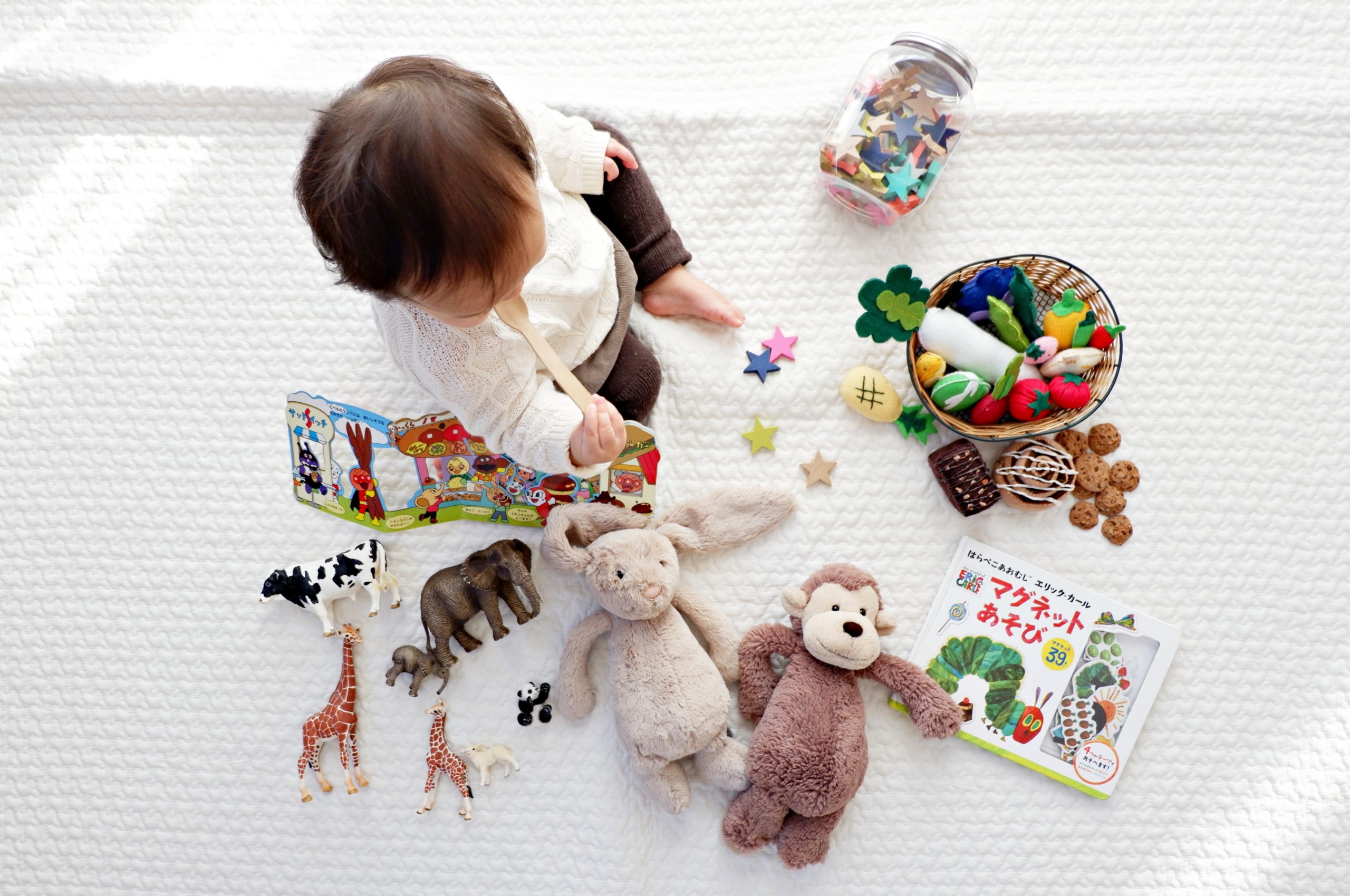I am thrilled to share some of my absolute favorite toys for kiddos that help boost expressive and receptive language skills! These can all be purchased off of Amazon and are reasonably priced. I have personal experience with these products as I have used them as therapy materials, or these are toys that my boys enjoy playing with – they are all child-approved!
Disclaimer: This post contains Amazon Affiliate links meaning that I will receive a small commission if you choose to purchase anything from the list below. Note that there is no extra cost to you and I am not being paid to promote any of the products.
#1

This Pop-Up Toy provides a fun and entertaining way to interact with your little one while fostering receptive and expressive language growth, in addition to working on motor skills! While recommended for 9-month-olds and up, I used this with my sons during tummy time to entertain them, and also put it on their highchair tray and played with them as they got a little older. One of the things I love the most about this toy is that it grows with the child.
Here are some ways you can use this toy at home to develop language skills:
- Teach animals. I’m sure this one is the most blatantly obvious things you can do with this toy. You can use this toy to teach your child the names of various animals through receptive language. When they’re younger and not talking, this gives you an opportunity to expose them to the same words over and over day-in and day-out so that they can learn what those words mean. As they get older, you can make this an expressive language task by asking them to name the animals.
- Work on opposites (i.e., “up”/”down“, “in”/”out”). You can do this as a receptive language task, where you talk about where the animals are. You can keep your sentence short, such as, “Elephant in,” or make it longer, “Look! The elephant is in.” Alternatively, you can work on expressive language as the child gets older and ask her to repeat after you. “Where is the tiger? Up! Can you say ‘up?'”
- Work on social skills. This is a wonderful toy to use to start building the idea of reciprocity or turn-taking. Let your child pop-up a few of the animals, then stop him and say “Great job! Now it’s my turn.” Take a quick turn and then have your child take another turn. You can continue to do this back-and-forth for popping toys up and pushing them down.
#2

A two-for-one deal with these blocks and stacking rings bundled together. Similar to the last toy, these ones target language and motor skills simultaneously, a win-win! Here are some reasons why I love these toys:
- Colors. This is a fantastic opportunity to teach colors. You can lay the groundwork early on and talk about what color each ring is or each block is. Since the shapes and blocks are similarly colored, you can show how a ring is “blue” and the square is also “blue.” As your child gets older, you can turn these tasks into expressive language tasks by asking him to repeat the name of the color.
- Shapes. Similar to colors, this is a fundamental concept to start building early on in childhood. What I like about the block shape sorter is that you can easily remove the lid and then place the shapes inside of the bucket one by one. Try to speak to your child in simple sentences when she is younger, such as, “Red triangle in!” Keep your voice sing-songy as you continue to build your child’s vocabulary.
- Cognitive thinking. These toys are puzzles and you can teach your child about concepts such as big vs little (rings) and matching (blocks). While your child won’t necessarily be able to stack the rings in the correct order by his first birthday or match all of the shapes in the sorter, these toys give you the opportunity to narrate about abstract concepts.
#3

The Dino Popper was a gift for our oldest son when he was about 7-months-old and it was an instant hit! So much so that when the batteries ran out, we let our dino popper take a month-long hibernation. He’s back up and running again now. Our youngest enjoys it but doesn’t quite have the same obsession with it. Here’s why I love it:
- Opposites. This toy offers a natural way to start building opposites in your child’s vocabulary. You can talk about whether you will be putting your ball “up high” or “down low” when you place it. Additionally, you can talk about how the balls are in the dinosaur or out of the dinosaur. When your little one is young, just narrate what is going on. As he gets older, ask him to complete short tasks (e.g., “Put the ball in the dinosaur.”) Then when he starts to talk, see if he can repeat some of your phrases back to you to help build his expressive language skills.
- Body parts. I really like that this toy makes it easy for me to teach my children about body parts. Usually, I focus on the face, horns, tongue, tummy, back, and tail. I just talk about what I see when the child is young. As they get older, I ask them to point to different parts. As their speech begins to develop, I see if they can label the different parts independently. A still more complex task is to ask “yes/no” questions as they get much older (e.g., “Do people have tails?”) As you can see, this toy will serve a child beyond just age 1 and has many opportunities for expressive and receptive language.
- Can bounce other toys. My eldest son quickly figured out that ANYTHING could go on top of his dinosaur toy. He was motivated to crawl all over the room, grab other toys (e.g., Little People, Duplo Legos, small stuffed animals, farm animals, the list is endless), and bring them back to the dinosaur to see if they would a.) make noise and b.) fit on top or inside. We turned it into a fun game where I would ask him to go and get a toy and bring it back to me so we could make it bounce. He would help make sure the Dino Popper was ON and, place the toy/s on top or inside, then begin reveling in the fun! Don’t be afraid to follow your child’s lead when it comes to the toy and build a language task around what she wants to do!
#4

PLAN Sensory Tumblers are simple and entertaining. They are easy to toss in your bag and not too noisy (except the sound one, of course) so you can play with them in waiting rooms or on-the-go. Here’s why I love them:
- Teach senses. Sensory learning is crucial to building a child’s language skills. Some children are auditory learners, tactile, or visual learners. In the beginning stages, your kiddos are just soaking everything in and trying to understand and differentiate the varying senses. These toys offer a way to talk about three different senses: touch, sight, and sound. You can talk about how soft something feels, how loud or quiet sounds can be, and teach your child about how cute he looks.
- Counting. There are only three of these objects so it is easy to start teaching basic counting skills with these toys. You can line them up and count “One, two, three.” Try taking one or two away or adding them back in one or two at a time. This will be primarily a receptive language task at first with you narrating the number of toys out before your child is able to express how many he sees, which is a later skill.
- Hide-and-seek. Since these toys are small, you can hide them underneath plastic cups and see if your child can find them. You can put out two to four cups, place the ball underneath one of them, then mix up the cups and ask, “Where is it?” When you find it, you can exclaim, “There it is! We found it!” This helps teach the concept of object permanence, that objects exist even when they cannot be seen.
#5

Last but not least, I have to recommend this farm set. This is one of the best gifts we have received as both of our boys are crazy about it. This particular farm set is quite entertaining. Read on to know more about why I love it:
- Animals. Similar to the first toy I recommended, this one is also a perfect one to teach animals. Between the first toy and this one, your little one will know jungle and farm animals in no time! I’m sure you know the drill by now – build vocabulary by talking to your child, ask your child if he or she can find a certain animal, and then ask if your child can imitate the word. Even if your child just says “c” for “cow” it shows that he is starting to make a linguistic connection. Very exciting!
- Teaching perspective. One neat thing about this farm set is that you can place animals on the second floor and face them forward. I remember showing that to my oldest son and his mind was blown when he saw the “inside/backside” of the farm. He learned that if he went to the back of the farm, put a horse on the second story, then looked at the horse from the front part of the farm that it was the same horse from a different point of view.
- Music. As we all know, the music on toys can drive us batty to the point of removing batteries or letting the toy take an extended rest (as I did with the dino popper). I’m not saying that the music on this toy won’t drive you crazy – it very well might if it’s overused. However, I like that the songs give you a great springboard of what you can do with your child when you play. The toy mentions the word silo (it’s never too early to start building your child’s vocabulary!) It asks your child to cover the cow in a nice warm blanket, which is great descriptive language and a direction. It is nice to follow the toy’s directions and show your child around the farm and all of its features. The options with this farm set are endless!
Hopefully you found some of these ideas helpful. Stay tuned and drop a comment below with any additional activity ideas you might have with these toys.


